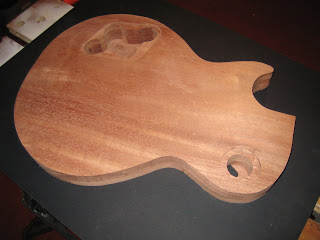Unfortunately, getting carried away with the build, I forgot to take a picture of the jig I created to make the flat surface toward the neck pocket on to which the fretboard sits. To do this, I basically created a box in to which the body of the guitar lays with its top upward. The sides of the box are flat but part way down the sides, I cut away an angle of 4.5 degrees. This basically means that if i set a router to just miss the upper surface of the guitar top, at a set point, running over the body, it will take away wood gradually more and more as it travels toward the neck. This creates a perfectly flat surface on to which the fretboard will sit.
You can see the end result here:

You can see a line around the edge of the guitar which is the depth the top will eventually be profiled down to. It already has a flat slope down to this point at the neck joint. This is the flat surface I cut and described above.
At this point, you can also see that the sides of the guitar have been sanded a little cleaner so that any loose bits of wood do not fall under the body or top when it is clamped for working on. This would lead to small indentations in the surface that may be impossible to sand out without spoiling the shape or profile.

Here you can see that I have started to route a flat surface around the edge of the upper body. This flat are goes almost all the way around the LP shape with the exception of the horn area, which has a more gentle slope. This flat plane goes in to the top by 27mm before starting to curve upward to create the unmistakable Gibson Les Paul violin shape top.
On top of the guitar body, you can see my small hand plane with curved base and blade that i purchased From Stewart Macdonals. I will hand plane the top down to the area routed out around the edge. The edge routing was done using a template Identical to that for cutting the body shape, only smaller.
I am planing as much as possible but leaving a very small lip, which i will remove with a palm sander to finish off the job.


Having taken off as much as is required with the plane, it is quite a time consuming job to finish off shaping with my small, Black and Decker palm sander. Takes ages, but the results are really good if you continue to check progress as you go to avoid over sanding and spoiling the curves.

Here is the top sanded to the correct shape without sanding to a final finish. It is very, very close to the original contour and well worth the effort of doing it by hand.





Notice inside the curve of the horn, the depth of the top is thicker than everywhere else. On modern Gibson Les Pauls, this is covered with the binding, which also gets thicker at this point. On a 1959 Gibson Les Paul, the binding was 2mm thick by 5mm deep and it ran all the way around the top at exactly the same size, so inside the horn area, a small part of the top was revealed underneath. I don't know if that was by design or a fault in the factory, but that's how it was. Gibson merely left it there and lacquered over it. I'm following the same style.
Very final shaping in preparation for the finish is yet to be done.





























